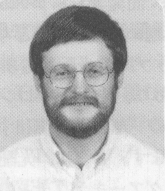

|
Andreas HeldTRC Information Integretion Laboratory |
I joined RWC only a few months ago, namely in April of this year, after graduation from Shizuoka University. Coming directly from university, I am one of the very few people that are directly employed by RWC, rather than being sent from the mother company.
During my stay at Shizuoka University, my main research topic was in the area of computer vision and image processing. In pallicular, I tried to address the question of how shape is perceived and understood. Shape, as we humans understand it, has many different aspects, some of which are rather difficult to make clear and to express by means of a computer. One major difficulty in computer perception is the need for common knowledge or common sense. That means, a lot of what we see, we understand based on our prior knowledge, that is, knowledge we acquired since we were born. So far, there is no way of modeling such common sense by computer. Therefore, I tried to avoid the problem of context dependency by addressing a seemingly simple task, the description and generalization of binary objects, that is, objects that are only given by their silhouette.
Although the task appears simple on first sight, not all context dependence can be avoided. This is due to the fact that the borderline between perceiving a certain shape as a circle rather than a square is not fixed. One of my main interests has therefore been the formulation of continuous shape descriptors, that is, shape descriptors that give, for instance, the degree of circleness, the degree of squareness, and so on, for any given shape.
Since joining RWC in April 1995, my research topic has shifted to robotics. The actual project I am working on aims at developing a so called "reception robot". A reception robot is an autonomous robot that can take over the work done by a receptionist, as can be found in most companies. The main tasks of a receptionist consist of greeting people, interacting with them to find out who they are and what they want, and finally to give them the needed information or to show them around. As such a robot is supposed to be working together with hurnan beings, it is important to make such a cooperation as smooth as possible.
Not only to avoid annoying the human counterpails, but as well to protect them from injulies due to the robot. This includes, that the robot has to be able to react quickly to changes in its environment, detecting obstacles, for instance, human beings in its path, and to avoid them.
At the moment, we are using a robot from Nomadic Technologies as a test bed for the reception robot. This robot comes equipped with a set of sonar and infrared sensors. The first step in using the system, therefore is to integrate the information obtained from those sensors. This should allow for simple navigation in an unknown environment. In a further step, the robot is equipped with a stereo camera pair and an aim.
The stereo camera is used for navigation tasks that can not easily be done by the other sensors, and for recognition of the environment, including face recognition of visitors. Besides we need to be able to recognize and read visiting cards; this is necessary to deal with people that have never been encountered before.
People visiting the RWC research center in Tsukuba might have come across a robot driving along the corridors. Although most of the aims of the present project are still far from being fulfilled, if you should come again to Tsukuba, please try to approach the robot, though carefully !